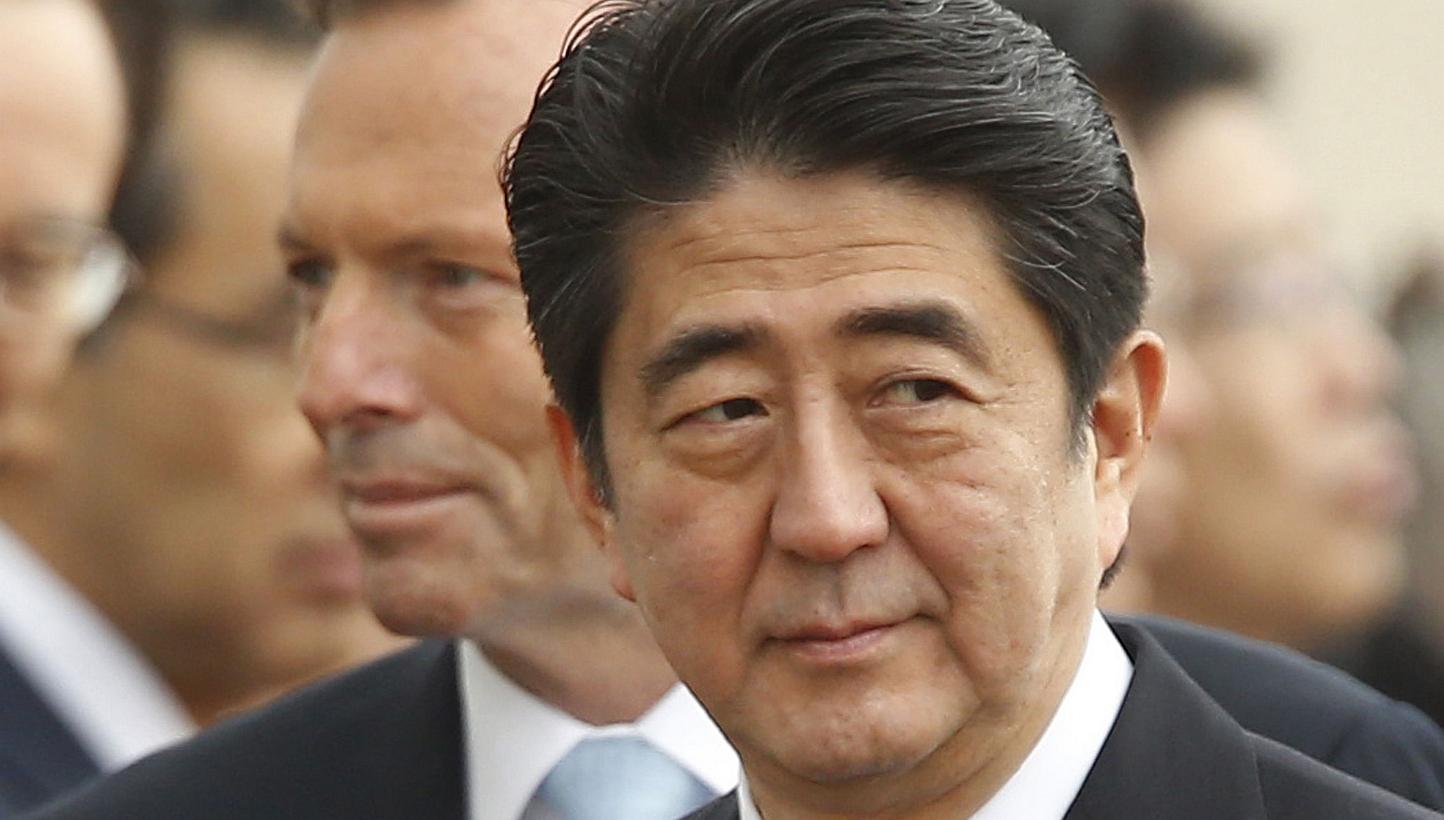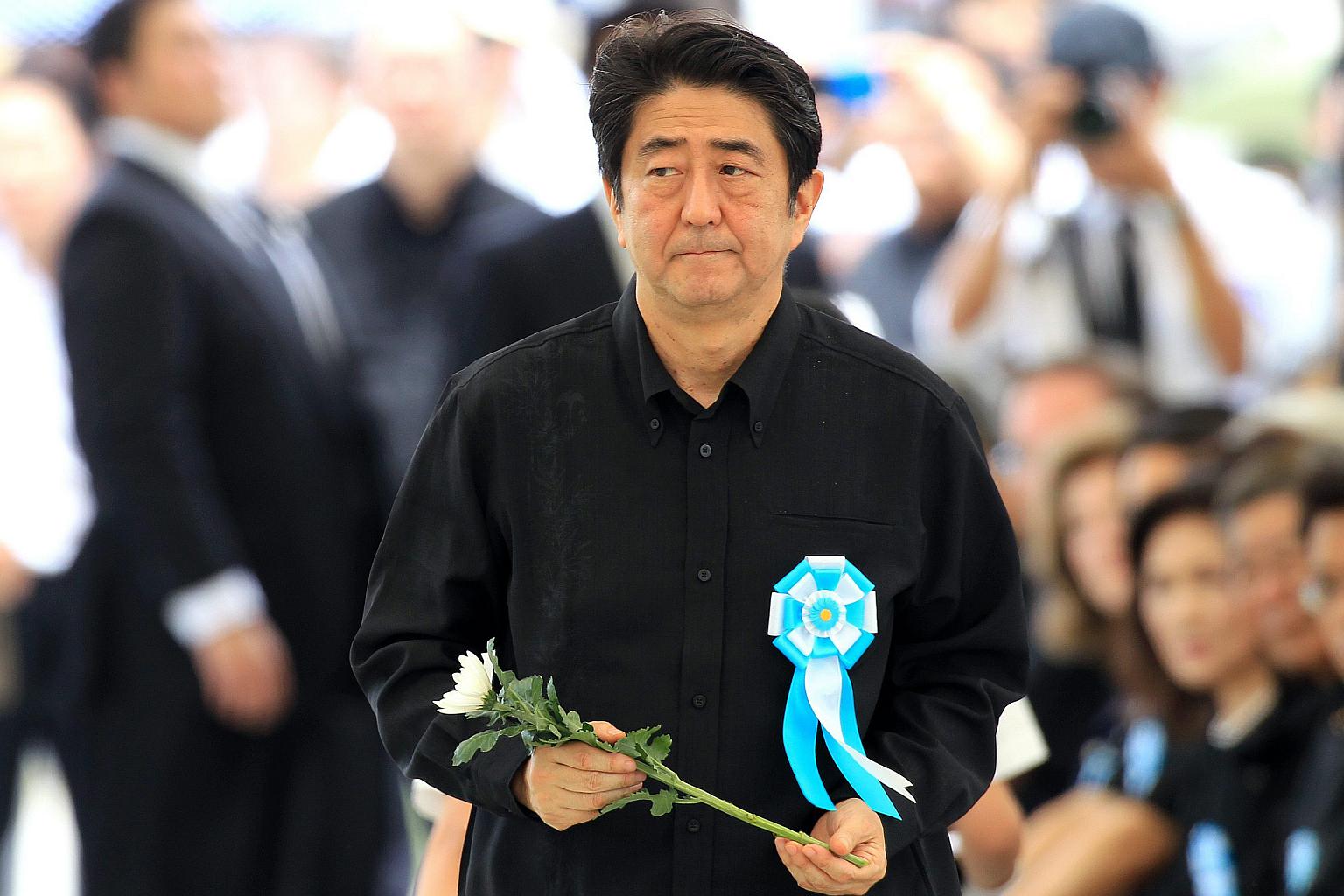Editorial Notes
Key to Abenomics and cutting emissions in Seoul
Editorial Notes is a selection of editorials from newspapers in the Asia News Network (ANN).
Sign up now: Get ST's newsletters delivered to your inbox

Japan's Prime Minister Shinzo Abe (right) participates in an official arrival ceremony with Australian Prime Minister Tony Abbott (back left) at Parliament House in Canberra on July 8, 2014. Japanese Prime Minister Shinzo Abe has been personally handed a letter from Sea Shepherd founder Paul Watson warning that any resumption of its whaling campaign will be vigorously challenged. -- PHOTO: AFP
Follow topic:
1. Seeking both growth and fiscal reform key to deepening Abenomics
Yomiuri Shimbun/ANN

The government has approved at a Cabinet meeting the Basic Policies for Economic and Fiscal Management and Reform, and a third version of its Japan Revitalization Strategy - the growth strategy of the administration of Prime Minister Shinzo Abe.
With the basic policies and revitalisation strategy, the government aims to realise high economic growth, such as through deregulatory measures to draw out the vigour of the private sector, and solve structural issues, including the elimination of fiscal deficits and the rebuilding of the social security system. It is appropriate to keep the basic strategy of seeking both economic growth and fiscal reconstruction.
Focus on productivity
At a meeting of the Council on Economic and Fiscal Policy that compiled the basic policies and the revitalisation strategy, Abe stressed, "I'm ready to carry out the economic and fiscal reform in an integrated manner with unflagging resolve."
At a meeting of the Council on Economic and Fiscal Policy that compiled the basic policies and the revitalisation strategy, Abe stressed, "I'm ready to carry out the economic and fiscal reform in an integrated manner with unflagging resolve."
Due to the effects of Abenomics, the economy is slowly recovering.
However, the nation's economy is only halfway to ending deflation.
To put a definite end to the so-called "two lost decades" following the collapse of the bubble economy in the early 1990s, it is important to accelerate the economic growth strategy that is the "third arrow" of Abenomics and strengthen the basic power of the Japanese economy.
The growth strategy this time indicated that Abenomics, which has so far attached importance to eliminating the lack of demand, has entered into its "second stage" aiming to overcome the constraints on the supply side, such as the declining population.
Increasing productivity is indispensable to continue economic growth with a declining workforce. The government's direction to make efforts to increase earning power through "productivity reform" in which private companies expand their investment in equipment, technology and personnel, is right.
The leading players for economic growth are private companies, themselves. The government needs to expand its policy support to back up "aggressive" decisions made by employers.
The revitalisation strategy included establishing a forum for dialogue between public and private sectors to urge private firms to step up investment. It is a timely action to that end.
The dialogue should be effectively utilised as a means to achieve a virtuous cycle of the economy through close cooperation between the public and private sectors, such as the trilateral meetings among the government, business circles and labour unions that led to large wage hikes.
Pursue deregulation efforts
However, mapping out the growth strategy has entered a third year. Therefore, it is unavoidable to feel that the policies, as a whole, seem to be small-scaled or lacking in fresh approaches.
However, mapping out the growth strategy has entered a third year. Therefore, it is unavoidable to feel that the policies, as a whole, seem to be small-scaled or lacking in fresh approaches.
For instance, the new growth strategy only states that the government will consider some ideas proposed for that initiative. Proposals include the introduction of a system designed to settle disputes arising from the termination of employment. The envisaged scheme would seek to resolve such problems between employers and discharged employees through monetary compensation. Another proposal would remove restrictions regarding the use of ordinary houses as public accommodations.
Some plans cited in the growth strategy are no better than extensions of existing measures, as shown by calls for expanding the scope of services to be offered under the upcoming My Number universal ID system and for improving the quality of vocational training.
We believe the new growth strategy can be commended for seeking to designate some universities as institutions dedicated to producing personnel as a driving force for technological innovation, as well as uniting business corporations and academic institutions in opening "excellent graduate schools" in which personnel with expertise in such fields as artificial intelligence would be brought together. However, a crucial part of these ideas - that is, their practical content - is obscure. We feel that these plans may end up being unable to fulfill their purposes.
It is essential to work out specific measures to ensure the plans will better serve their aims, while also strongly promoting these schemes.
The two previous growth strategies achieved a certain measure of success in fulfilling their purposes. For instance, a process was put in motion to reduce the effective corporate tax rate. Reforms were also initiated regarding rock-solid regulations in such fields as agriculture, labour and medicine.
In many cases, however, such reform efforts were left incomplete or put off due to objections from government ministries and industrial associations during the process of considering these initiatives. A typical example of this was a proposed end to regulations on farmland ownership by corporations.
Such was also the case with so-called national strategic special zones in which deregulation is to be promoted ahead of other areas. Business circles have said progress has been too slow in these zones.
To begin with, growth strategies and regulatory reforms are the kinds of task that requires a lot of time and effort. We believe efforts should be made to seriously reexamine the work initiated but still left undone and make steady progress in achieving the intended goals, not just try to accomplish something new.
Another inevitable task is to carry out fiscal reconstruction so our nation's ability to achieve medium- and long-term growth can be improved. If the nation lacks a sound fiscal foundation, it will be difficult to flexibly implement necessary policy measures to address an economic downturn and other problems.
Painful cuts needed
A fiscal health restoration plan included in the latest basic policies is based on the assumption that the nation will achieve a significant 2 per cent economic growth in real terms, whereby tax revenue will be greatly increased. Therefore, the basic policies are less than satisfactory in seeking cuts in government expenditures, a vitally important goal to be pursued in this respect.
A fiscal health restoration plan included in the latest basic policies is based on the assumption that the nation will achieve a significant 2 per cent economic growth in real terms, whereby tax revenue will be greatly increased. Therefore, the basic policies are less than satisfactory in seeking cuts in government expenditures, a vitally important goal to be pursued in this respect.
Another disappointing feature of the basic policies concerns how to curb social security spending, the greatest focus of the fiscal reconstruction effort. The policies only cited some tasks as matters for discussions. Questions must be raised about the appropriateness of not addressing such issues as when and how to carry out system reforms necessary for reducing benefits and placing a greater financial burden on subscribers.
A key obligation facing political leaders is to honestly tell people that there is a need to promote reforms that entail pain - a task essential for gaining sympathetic understanding from the public. Given this, the prime minister will be tested over whether he will be able to play a leadership role in achieving the goal.
Full-scale work to put together a budget plan for fiscal 2016 will start in the summer. The acid test of that effort is whether various specific measures to reduce government spending will be taken as initial but steady steps toward fiscal reconstruction.
2. Emissions cut in Seoul cannot remain a task for tomorrow
The Korea Herald/ANN

Its planned contribution, which was submitted to the U.N. Climate Change Secretariat later in the day, calls for reductions of 25.7 per cent from the country's business-as-usual level ― the amount of emissions forecast if no action is taken ― by 2030. The remaining 11.3 per cent cut would come in the form of purchasing carbon credits to offset emissions.
On June 11, the Ministry of Trade, Industry and Energy suggested four options for setting Korea's emissions reduction goal. They ranged from the minimum 14.7 per cent to the maximum 31.3 per cent cut from the country's BAU level by 2030.
Without any measures to reduce greenhouse gas emissions, Korea's overall emissions are projected to grow by an annual average of 1.3 per cent over the next 15 years to reach 850.6 million tons of carbon dioxide equivalent by 2030, according to a report released by the ministry.
Even if the most aggressive option had been adopted, it would still have marked a setback from a pledge made by the previous administration under President Lee Myung-bak to cut the country's overall emissions by 30 per cent from the BAU level by 2020.
During his phone talks with President Park Geun-hye a day after Seoul put forward the four scenarios, U.S. President Barack Obama asked her to set an ambitious goal in cutting greenhouse gas emissions, citing efforts to ensure the success of a crucial global climate conference to start in Paris in November. Though wrapped in diplomatic rhetoric, his request was seen by officials here as putting pressure on Seoul to set a higher target.
Tuesday's announcement made by Prime Minister Hwang Kyo-ahn apparently took Obama's wish to heart. Hwang tried to justify the sudden shift in the government's position by noting Korea has played a leading role in fighting climate change. It would have been better for the Park administration not to attempt to backpedal on Seoul's earlier pledge at the risk of damaging Korea's international credibility.
Tuesday's announcement made by Prime Minister Hwang Kyo-ahn apparently took Obama's wish to heart. Hwang tried to justify the sudden shift in the government's position by noting Korea has played a leading role in fighting climate change. It would have been better for the Park administration not to attempt to backpedal on Seoul's earlier pledge at the risk of damaging Korea's international credibility.
Seoul's latest commitment is designed to lessen the burden on local manufacturers by purchasing carbon credits through an international market mechanism that has yet to take shape. As some critics note, this scheme might result in getting Korea to shoulder more costs.
Still, business organisations and energy companies here immediately issued a statement against the government's emissions reduction goal, which they claimed disregarded Korea's industrial conditions and could push them over the edge. Given the country is the seventh-biggest emitter in the world, it does not make global sense to argue that Korea should continue to be treated as a developing country not bound by obligations to cut emissions.
Korean companies should try to find opportunities in the shift in global investment toward projects to mitigate climate change. They also need to prepare themselves for an era in which tightened standards for reducing emissions become the norm in international trade.
Now is the time for all sectors in the country to perceive that meeting obligations in curbing global warming can no longer remain a task for tomorrow.

